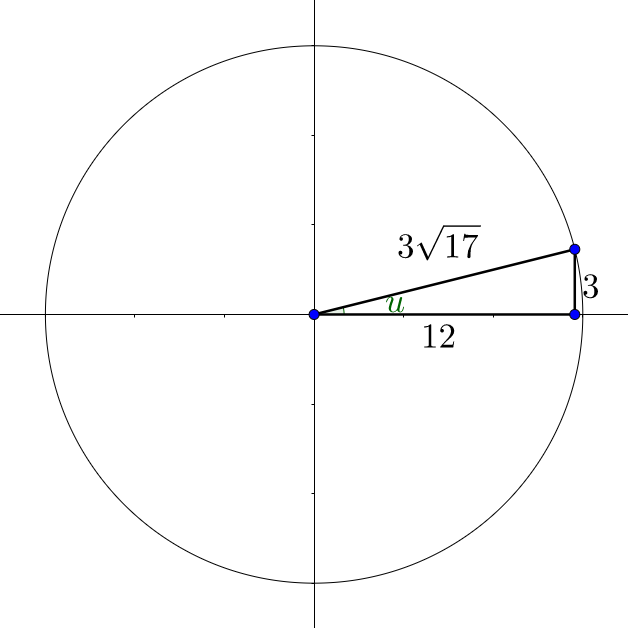Precalculus by Richard Wright
Precalculus by Richard Wright
Watch out for false prophets. They come to you in sheep’s clothing, but inwardly they are ferocious wolves. By their fruit you will recognize them. Matthew 7:15-16a NIV
Summary: In this section, you will:
SDA NAD Content Standards (2018): PC.5.1

A roof is planned with a steepness of 3/12 meaning that the angle formed with horizontal is \(\tan θ = \frac{3}{12}\). To make snow slide off easier, the designer wants to double the angle of the roof. What would be the new steepness? The formulas for this lesson will be used to solve problems like these.
The double-angle formulas are derived from the sum formulas from lesson 5-05. Let u = v in the sum formulas and simplify.
A roof is planned with a steepness of 3/12 meaning that the angle formed with horizontal is \(\tan θ = \frac{3}{12}\). To make snow slide off easier, the designer wants to double the angle of the roof. a) What would be the new steepness? b) Also find sin 2θ and c) cos 2θ.
Solution
By steepness, the problem is asking for what is tan 2θ? Use the double-angle formula for tangent.
$$\tan 2θ = \frac{2 \tan θ}{1 - \tan^2 θ}$$
$$= \frac{2\left(\frac{3}{12}\right)}{1 - \left(\frac{3}{12}\right)^2}$$
$$= \frac{2\left(\frac{1}{4}\right)}{1 - \left(\frac{1}{4}\right)^2}$$
$$= \frac{\frac{1}{2}}{1 - \frac{1}{16}}$$
$$= \frac{\frac{1}{2}}{\frac{15}{16}}$$
$$= \frac{1}{2} ⋅ \frac{16}{15}$$
$$= \frac{8}{15}$$
Tangent gives the ratio opposite/adjacent in right triangles. Draw the triangle and use the Pythagorean theorem to find the hypotenuse.

a2 + b2 = c2
122 + 32 = hyp2
153 = hyp2
$$hyp = 3\sqrt{17}$$
So \(\sin θ = \frac{3}{3\sqrt{17}} = \frac{\sqrt{17}}{17}\) and \(\cos θ = \frac{12}{3\sqrt{17}} = \frac{4\sqrt{17}}{17}\). Now use the double angle formula for sine.
sin 2θ = 2 sin θ cos θ
$$= 2\left(\frac{\sqrt{17}}{17}\right)\left(\frac{4\sqrt{17}}{17}\right)$$
$$= \frac{136}{289} = \frac{8}{17}$$
Cosine has three options for the double-angle formula. Choose one that is convenient.
cos 2θ = 2 cos2 θ − 1
$$= 2 \left(\frac{4\sqrt{17}}{17}\right)^2 - 1$$
$$= 2 \left(\frac{16}{17}\right) - 1$$
$$= \frac{32}{17} - 1$$
$$= \frac{15}{17}$$
If \(\sin α = \frac{24}{25}\), find sin 2α, cos 2α, and tan 2α.
Answer
\(\frac{336}{625}\), \(\frac{527}{625}\), \(\frac{336}{527}\)
Find all solutions on the interval [0, 2π) of sin x + sin 2x = 0.
Solution
Start by using the double-angle formula for sine.
sin x + 2 sin x cos x = 0
Factor out sin x.
sin x (1 + 2 cos x) = 0
Set each factor equal to zero and solve.
| sin x = 0 | 1 + 2 cos x = 0 |
| \(\cos x = -\frac{1}{2}\) | |
| x = 0, π | \(x = \frac{2π}{3}, \frac{4π}{3}\) |
Solve on the interval [0, 2π) for sin2 x + cos 2x = 0.
Answer
\(\frac{π}{2}\), \(\frac{3π}{2}\)
Derive a triple-angle formula for sin 3x.
Solution
Start by rewriting the sin 3x as sin (2x + x) so a sum formula can be used.
sin 3x = sin (2x + x)
= sin 2x cos x + cos 2x sin x
Use double-angle formulas.
= (2 sin x cos x)cos x + (2 cos2 x − 1)sin x
Multiply and distribute.
= 2 sin x cos2 x + 2 sin x cos2 x − sin x
Combine like terms.
= 4 sin x cos2 x − sin x
Use a Pythagorean identity to change cos2 x to 1 − sin2 x so that only sine is used.
= 4 sin x (1 − sin2 x) − sin x
Distribute.
= 4 sin x − 4 sin3 x − sin x
= 3 sin x − 4 sin3 x
Derive a quadruple angle formula for cos 4x.
Answer
\(8\cos^4 x - 8\cos^2 x + 1\)
The power-reducing formulas change a squared trigonometric expression to no exponent. These are derived from taking the double-angle formulas for cosine and solving for the sin2 u or cos2 u. Tangent is then \(\frac{\sin u}{\cos u}\).
Rewrite sin4 x as a sum of 1st powers of cosine.
Solution
Rewrite sin4 x in terms of sin2 x.
sin4 x = sin2 x sin2 x
Substitute the power-reducing formula for sine.
$$= \left(\frac{1 - \cos 2x}{2}\right)\left(\frac{1 - \cos 2x}{2}\right)$$
Multiply.
$$= \frac{1}{4}\left(1 - 2\cos 2x + \cos^2 2x\right)$$
Since a new squared term resulted, use the power-reducing formula for cosine with u = 2x.
$$= \frac{1}{4}\left(1 - 2\cos 2x + \left(\frac{1 + \cos 2\left(2x\right)}{2}\right)\right)$$
Get a common denominator.
$$= \frac{1}{4}\left(\frac{2}{2} - \frac{4\cos 2x}{2} + \frac{1 + \cos 4x}{2}\right)$$
Multiply the denominator and combine like terms.
$$= \frac{1}{8}\left(3 - 4\cos 2x + \cos 4x\right)$$
Rewrite cos3 x as a sum of 1st powers of cosine.
Answer
\(\frac{1}{2}\left(\cos x + \cos x \cos 2x\right)\)
The half-angle formulas are derived from the power-reducing formulas. Let the angle be \(\frac{u}{2}\), then square root both sides.
The ± sign means to choose the correct sign based on which quadrant the half-angle is in on the unit circle.
Find the exact value of sin 165°.
Solution
Notice that \(165° = \frac{330°}{2}\), a half-angle formula can be used with u = 330°.
$$\sin 165° = \sin \frac{330°}{2}$$
$$= ±\sqrt{\frac{1 - \cos 330°}{2}}$$
$$= ±\sqrt{\frac{1 - \frac{\sqrt{3}}{2}}{2}}$$
$$= ±\sqrt{\frac{\frac{2}{2} - \frac{\sqrt{3}}{2}}{2}}$$
$$= ±\sqrt{\frac{\frac{2 - \sqrt{3}}{2}}{2}}$$
$$= ±\sqrt{\frac{2 - \sqrt{3}}{4}}$$
$$= ±\frac{\sqrt{2 - \sqrt{3}}}{2}$$
Because 165° is in quadrant II and sine is positive in quadrant II, only the + should be used from the ±.
$$\sin 165° = \frac{\sqrt{2 - \sqrt{3}}}{2}$$
Find the exact value of \(\cos \frac{π}{8}\).
Answer
\(\frac{\sqrt{2+\sqrt{2}}}{2}\)
Find all the solutions of \(\cos x = 2 \sin^2 \frac{x}{2}\).
Solution
The quickest way to solve this equation is to use a half-angle formula for \(\sin \frac{x}{2}\). The square on this term will cancel the square root in the half-angle formula.
$$\cos x = 2 \sin^2 \frac{x}{2}$$
$$\cos x = 2 \left(±\sqrt{\frac{1 - \cos x}{2}}\right)^2$$
$$\cos x = 2\left(\frac{1 - \cos x}{2}\right)$$
$$\cos x = 1 - \cos x$$
$$2 \cos x = 1$$
$$\cos x = \frac{1}{2}$$
$$x = \frac{2π}{3} + 2πn, \frac{5π}{3} + 2πn$$
Solve on the interval [0, 2π) for \(\cos x = \cos^2 \frac{x}{2}\).
Answer
0
The ± sign means to choose the correct sign based on which quadrant the half-angle is in on the unit circle.
Helpful videos about this lesson.